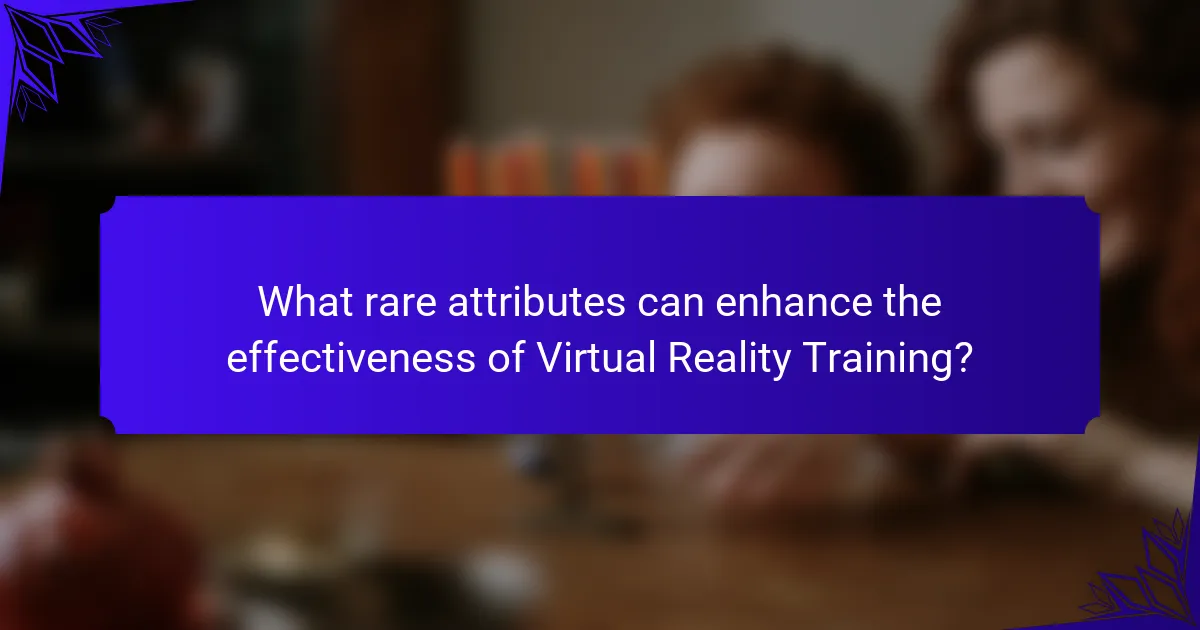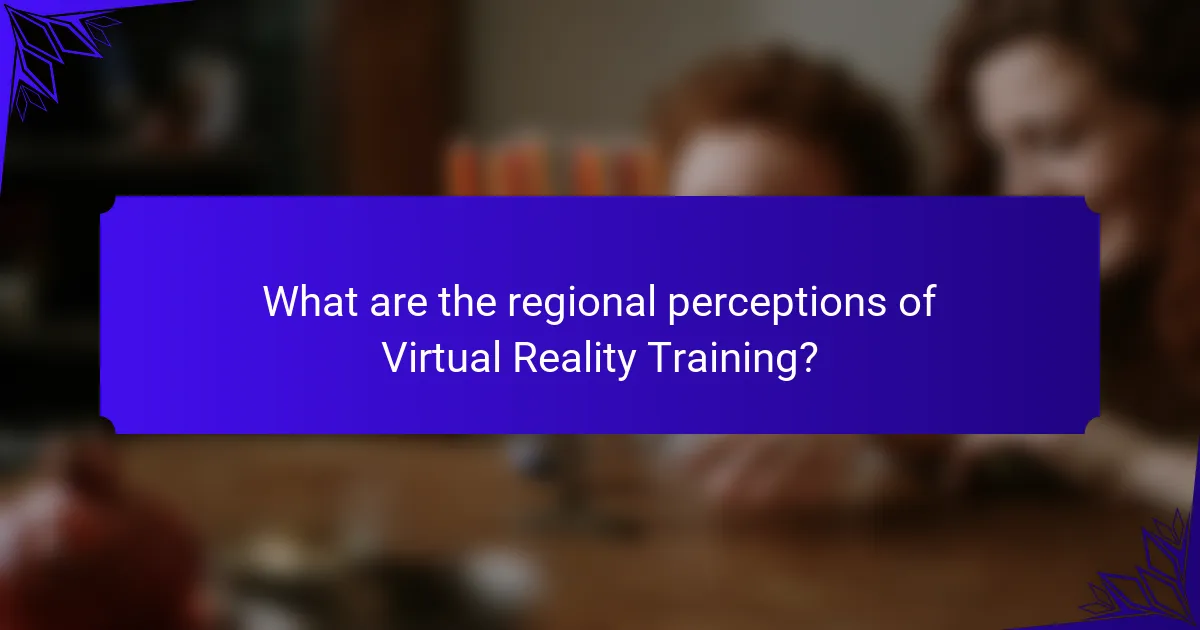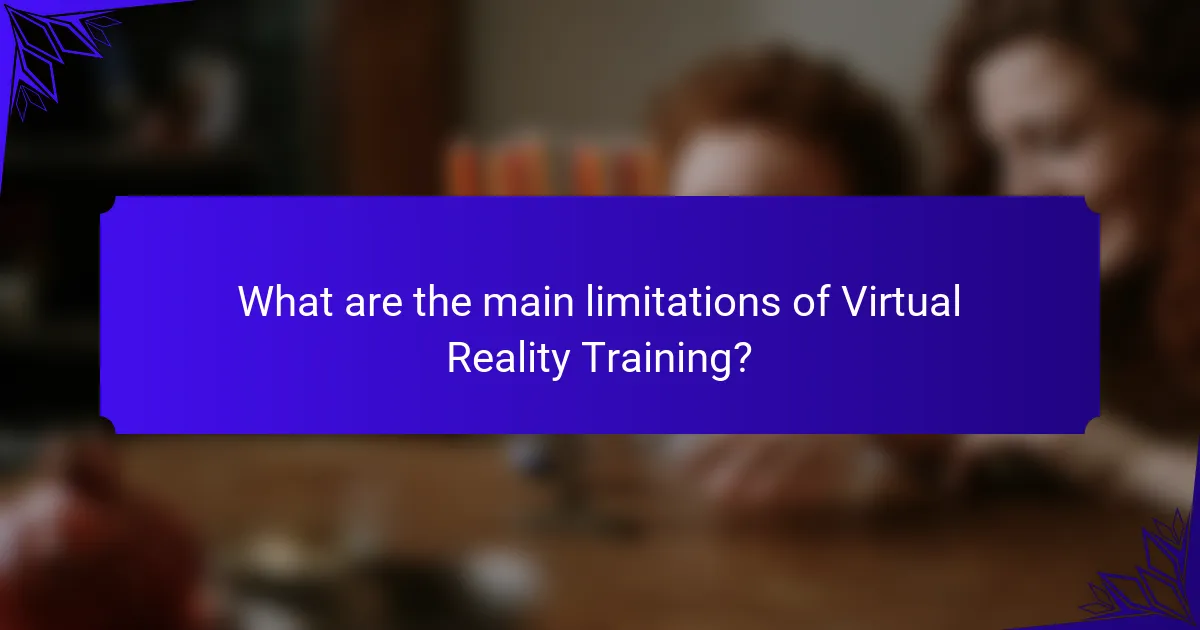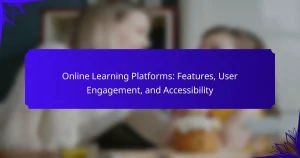Virtual reality training significantly enhances learning experiences by providing realistic simulations that improve skill acquisition and retention. This approach leads to deeper engagement and better performance outcomes. The article explores the universal benefits of VR training, its unique features, regional perceptions, limitations, and strategies for effective implementation. By understanding these aspects, organizations can leverage VR as a powerful educational tool.

What is Virtual Reality Training?
Virtual reality training uses immersive technology to enhance learning experiences and effectiveness. This approach provides realistic simulations that improve skill acquisition and retention. Studies show that learners engage more deeply, leading to better performance outcomes. Additionally, VR training can be tailored to specific industries, making it a unique asset for sectors like healthcare and aviation. Overall, the effectiveness of virtual reality training stems from its ability to create engaging, interactive environments that facilitate practical learning.
How does Virtual Reality Training differ from traditional training methods?
Virtual Reality Training offers immersive experiences that enhance learning compared to traditional methods. It engages users through interactive simulations, improving retention and application of skills. Traditional training often relies on passive learning, limiting engagement and practical experience. VR training provides realistic scenarios, allowing for experiential learning that is difficult to replicate in conventional settings. This unique attribute of immersion fosters deeper understanding and confidence in skill application.
What are the key components of Virtual Reality Training?
The key components of Virtual Reality Training include immersive environments, interactive simulations, real-time feedback, and customizable learning paths. These elements enhance engagement and effectiveness, allowing learners to practice skills in a safe, controlled setting. Immersive environments provide realistic scenarios, while interactive simulations enable hands-on experience. Real-time feedback helps learners adjust their performance immediately, and customizable learning paths cater to individual needs and goals.

What are the universal benefits of Virtual Reality Training?
Virtual Reality Training offers universal benefits such as enhanced engagement, improved retention, and safe practice environments. These immersive learning experiences allow users to simulate real-world scenarios, leading to better skill acquisition. Studies show that VR training can increase retention rates by up to 75%, making it a highly effective educational tool. Additionally, it provides unique attributes like personalized learning paths that cater to individual needs, enhancing overall training effectiveness.
How does Virtual Reality enhance engagement and retention?
Virtual Reality significantly enhances engagement and retention by creating immersive learning experiences. Users experience realistic scenarios that boost focus and motivation. Studies show that VR training can improve information retention rates by up to 75%. This unique attribute of VR allows learners to practice skills in a safe environment, leading to better performance in real-world applications. As a result, organizations can achieve higher training effectiveness and reduced costs associated with traditional methods.
What role does interactivity play in learning outcomes?
Interactivity significantly enhances learning outcomes in virtual reality training by fostering engagement and retention. Immersive experiences allow learners to practice skills in realistic scenarios, leading to improved knowledge application. Research indicates that active participation boosts memory retention by up to 75%. Additionally, interactivity supports personalized learning paths, accommodating diverse learning styles. This adaptability is a unique attribute of virtual reality, making it an effective educational tool.
How does Virtual Reality Training accommodate different learning styles?
Virtual Reality Training accommodates different learning styles by providing immersive, interactive experiences tailored to individual preferences. Visual learners benefit from engaging graphics and simulations, while kinesthetic learners thrive in hands-on environments. Auditory learners can absorb information through guided narratives and feedback. This adaptability enhances retention and application of knowledge, making VR training effective across diverse learning styles.

What unique features set Virtual Reality Training apart?
Virtual Reality Training stands out due to its immersive learning environment, which enhances engagement and retention. Unique features include realistic simulations that replicate real-world scenarios, enabling hands-on practice without risk. Additionally, the adaptability of VR training allows customization to fit various learning styles and paces. The capability for real-time feedback during training sessions further distinguishes it, promoting immediate skill application and improvement.
How does immersive storytelling impact learning?
Immersive storytelling enhances learning by engaging learners emotionally and cognitively. This approach fosters deeper understanding and retention of information. Research shows that virtual reality training can improve knowledge retention by up to 75% compared to traditional methods. Additionally, immersive experiences allow learners to practice skills in realistic scenarios, increasing confidence and competence. This unique attribute of virtual reality training makes it an effective educational tool, especially for complex subjects.
What are the advantages of real-time feedback in VR training?
Real-time feedback in VR training enhances learning by providing immediate insights into performance. This instant evaluation allows learners to adjust their actions and strategies effectively.
One advantage is the increased engagement level; participants feel more involved when they receive timely responses. Additionally, real-time feedback facilitates personalized learning experiences, catering to individual needs and learning paces.
Moreover, it promotes retention of information, as learners can correct mistakes on the spot. This immediate correction helps reinforce concepts and skills, making the training more effective.
Overall, the integration of real-time feedback in VR training leads to improved performance outcomes and a more immersive learning experience.

What rare attributes can enhance the effectiveness of Virtual Reality Training?
Rare attributes that can enhance the effectiveness of Virtual Reality Training include personalized learning pathways, real-time feedback mechanisms, and adaptive difficulty levels. These elements tailor the experience to individual learner needs, improving engagement and retention. Additionally, incorporating biometric feedback can create immersive scenarios that respond to user emotions, further enhancing learning outcomes.
How can VR simulations replicate high-risk environments?
VR simulations can effectively replicate high-risk environments by immersing users in realistic scenarios. Advanced graphics, real-time feedback, and haptic technology enhance the experience, allowing trainees to practice decision-making and skills without real-world consequences. This immersive training improves retention and preparedness, making it a valuable tool in fields such as aviation, medicine, and emergency response. Additionally, VR can simulate rare situations that may not be frequently encountered, ensuring comprehensive training.
What innovative applications of VR training are emerging in various industries?
Innovative applications of VR training are transforming various industries by enhancing engagement and retention. In healthcare, VR simulates surgeries, allowing medical professionals to practice in a risk-free environment. The aviation sector uses VR for pilot training, providing realistic flight scenarios. Retail companies implement VR for immersive customer experiences, improving sales training. Construction firms utilize VR to visualize projects, enhancing safety and efficiency. Additionally, the military employs VR for tactical training, enabling soldiers to experience combat scenarios without real-world risks. These applications demonstrate VR’s unique ability to create impactful learning experiences across diverse fields.

What are the regional perceptions of Virtual Reality Training?
Regional perceptions of Virtual Reality Training vary significantly based on cultural attitudes toward technology and education. In North America, there is a strong acceptance of VR as an innovative training tool, often linked to enhanced engagement and retention rates. Conversely, in some parts of Asia, skepticism persists regarding the effectiveness of VR compared to traditional methods.
In Europe, perceptions are mixed; while countries like Germany embrace VR for industrial training, others are cautious about its cost-effectiveness. Additionally, regions with limited access to technology may view VR training as impractical.
Overall, the effectiveness of Virtual Reality Training is often judged by local educational standards and technological infrastructure, influencing its adoption and implementation across different regions.
How is Virtual Reality Training being adopted in educational systems globally?
Virtual reality training is increasingly being integrated into educational systems worldwide. Schools and universities utilize VR to enhance engagement and improve learning outcomes.
Countries like the United States and Japan lead in VR adoption, focusing on immersive experiences in subjects like science and history. Research indicates that students using VR show a 30% improvement in retention rates compared to traditional methods.
Additionally, unique VR applications, such as virtual field trips, allow students to explore complex environments without leaving the classroom. This innovative approach not only broadens access to resources but also fosters collaboration among students.
As a result, educational institutions are investing in VR technology to create interactive and effective learning environments, preparing students for future challenges.
What challenges do different regions face in implementing VR training?
Different regions face various challenges in implementing virtual reality training due to factors like infrastructure, cost, and cultural acceptance. Regions with limited technological resources struggle to provide the necessary hardware and internet connectivity. High development and maintenance costs can deter organizations from adopting VR training. Cultural attitudes towards technology and education also influence the acceptance and effectiveness of these immersive learning experiences. For example, some regions may prioritize traditional training methods over innovative approaches.

What are the main limitations of Virtual Reality Training?
Virtual Reality Training has several limitations that affect its effectiveness. High costs for hardware and software can restrict access for some organizations. Technical issues like motion sickness and equipment malfunctions can hinder user experience. Limited content availability may not cover all training scenarios. Additionally, the need for specialized training for instructors can complicate implementation. Lastly, some learners may prefer traditional methods, impacting engagement.
What are the technological barriers to widespread adoption?
Technological barriers to widespread adoption of virtual reality training include high costs, limited hardware accessibility, and insufficient content development. These factors hinder scalability and integration into existing educational systems. High-quality VR systems can be expensive, making them inaccessible for many institutions. Additionally, the lack of diverse and engaging training content limits user interest and effectiveness. Compatibility issues with existing technologies can further complicate implementation.
How do costs impact the scalability of VR training solutions?
Costs significantly impact the scalability of VR training solutions by influencing development, deployment, and maintenance. High initial investment can limit access for smaller organizations, while ongoing costs affect long-term sustainability.
For instance, the cost of VR hardware and software can deter adoption, especially in industries with tight budgets. Training content creation also incurs expenses, which can affect the frequency and quality of updates.
As a result, organizations must weigh the potential return on investment against these costs. Effective budgeting and funding strategies are essential for scaling VR training solutions successfully.

What best practices should be followed for effective Virtual Reality Training?
To ensure effective Virtual Reality Training, focus on immersive content, user engagement, and realistic simulations. Integrate feedback mechanisms to assess learner progress and adapt experiences accordingly. Leverage collaborative environments to enhance social learning and retention. Prioritize accessibility to accommodate diverse learning needs.
What common mistakes should be avoided in VR training development?
To enhance VR training development, avoid common mistakes such as neglecting user experience, failing to define clear learning objectives, and overlooking hardware limitations. Additionally, ensure content relevance and interactivity to maintain engagement. Focus on iterative testing and feedback to refine training modules.
How can organizations optimize their VR training programs for better outcomes?
Organizations can optimize their VR training programs by focusing on immersive content, user feedback, and performance metrics. Prioritize realistic scenarios that enhance engagement and retention. Incorporate adaptive learning technologies to personalize experiences based on individual progress. Regularly analyze outcomes to refine training modules and ensure they meet organizational goals. Establish a feedback loop with participants to continuously improve the training experience.
What expert insights can guide future developments in Virtual Reality Training?
Expert insights suggest that future developments in Virtual Reality Training should focus on enhancing user engagement and adaptability. Immersive experiences can be tailored to individual learning styles, increasing effectiveness. Research indicates that incorporating real-time feedback mechanisms significantly boosts retention rates. Additionally, leveraging advancements in AI can personalize training scenarios, making them more relevant and impactful. Continuous evaluation of training outcomes will ensure that VR applications evolve to meet changing industry needs.


